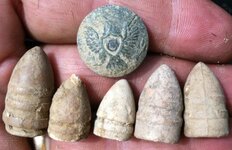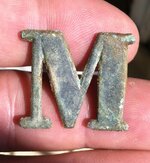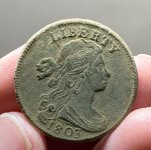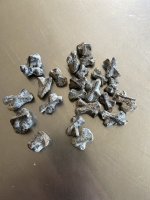coinshooter
Bronze Member
This is from a guys really cool site. Great hunting tips and maybe if you live in this county (Wicomico County) , an excellent lead to some really cool sites to hunt.
Check out the map on the link below. It shows all of the residences in that area. I don't even know where this county is, but it may be in Virginia. This guy sounds like he is definitely someone to contact if you live near him. Below is part of his page on ebay.
______________________________________________________________
The atlas
My biggest secret to finding treasures is research right? Yes, of course, I already told you that on the questions and answers page. Well, many moons ago when I was sifting through the Wicomico County library, I actually stumbled onto a treasure right in the map room! What did I find? Well… I found an old 1876 atlas! Sounds like no big deal aye? Well, this old collection of maps shows the location of every frickin’ house, store, tavern, school, road, town, church, blacksmith shop, creek, river, ocean….well, you name it, it is on there! This atlas is responsible for approximately 99% of my metal detecting collection. And the money I have made from selling some of this stuff will easily allow me to retire 10 years earlier than I thought I would be able to.
Why is this map so important?
First, take a look at one of the maps from this atlas
http//www.mikehitch.com/bcdist.gif (maps courtesy of Mike Hitch)
Notice the little black squares? Those are houses. Every dwelling, business, saw mill, landing etc. could be found on here. The amazing thing is many of these roads are identical to today’s roads. (See the note below about old roads) So a person is able to take a modern map and an atlas map and overlay them to learn the location of long forgotten places. Thankfully most of our area is agricultural lands and all those houses and churches and schools that aren’t there are now are just waiting vacant in a farm field…just waiting to be rediscovered! (click here to read about one of my first discoveries using this atlas)
You will likely be able to find a similar atlas of your area. They were actually common in the mid 19th century and I bet most areas will have them. I was able to find an 1865 atlas of Delaware. The earlier the better!
Mike Hitch has been kind enough to let me link to his genealogy site. By chance, this fellow has scanned much of the atlas and you will have direct access these valuable maps.
Main site http//www.mikehitch.com
Just the Atlas http//www.mikehitch.com/1876maps.htm
One of my first discoveries using the 1876 Atlas
With a little insight on how I could use the atlas I found at the local library, I headed down to an area that is almost entirely farm fields today but was littered with homes and businesses in 1876. I compared the old main road and new main road and realized they were EXACTLY the same. I then realized DOZENS of dwellings and businesses could easily be located and metal detected by noting their position in relation to the curves in the road. Verification of their location was done manually done by walking and looking for occupation evidence. (See Occupation evidence) After obtaining permission from the farmer, I headed out into the field and began searching. IMMEDIATELY the relics were being dug from the ground. In only ? hour, I had dug several old copper and brass coat buttons, a few old buckles and an 1841-seated liberty dime. This continued throughout 3-4 hours and I mean I had ALOT of coins and relics. I found several coins dating from an 1838 large cent to several Indian head pennies and literally pockets full of relics. Among the Indian heads was an 1866 and 1872. I realized quickly how truly valuable this atlas was and would be. I didnt know it then but I realize now, if I sold just these first few relics and coins on eBay, I could easily make more than $150-$200. That’s like $40-$50 an hour. Not too bad for a country boy.
I used this approach over the next few years my collection grew from finding common wheat pennies and Mercury dimes at obvious schools and churches to finding rare bust coinage, scarce relics and state issued coppers and Spanish cobs and colonial silver. And so can you, I have pretty much given you the key to the treasure chest…
2 Dig a plug and put it back.
When hunting a school, church or other well manicured area. Try using a Frisbee to put the excess dirt in. You can dig a nice 6” diameter plug, put it upside down in the Frisbee and keep digging the hole until you get the target. Afterwards, you can put the dirt back into the hole and neatly tamp the plug into the hole and the experienced detectorist can make you think no hole had ever been dug!
3 Permission
You need to find out who owns the land you want to dig up! There is no part of the Earth that isn’t owned. It may be state owned or privately owned. You need to find out the laws before you go digging on land that isn’t yours. We try our best to secure permission before we ever start digging.
4 Occupation evidence
What the hell is occupation evidence? Well, go back to the section where I explain how to locate sites by overlaying the old atlas maps with a new map. Lets say you have a good idea where a house or business was located in an open field. At that point you can take the detector out and scan the area but I recommend first doing a visual search to see if it’s the right spot. (These atlases are so precise; I can only vouch for one or 2 of their mistakes in my research experience.) Look at this picture ,,,,,,,, This is what you will see if there is an occupation present. The photo here is loaded with brick, oyster shells and pieces of broken crockery from centuries past. In some cases, broken pieces of clay pipe will be present and that is evidence of a REALLY OLD SIGHT! If you see clay pipe, for god sakes man, get permission and get out that metal detector and search!
Note In my readings and research I have learned that many of the roads we use today were old Indian roads and even before that, the Indians got many of their old roads from old deer trails. Quite interesting!
Occupation evidence in the middle of a farm field Pieces of
brick, shell & pottery and a few bits of clay tobacco smoking pipe
5 Hugh Meise and farm fields
Hugh Meise is synonymous with “permission getter”. This guy deserves his own area on my page for his contribution to my collection. Keep in mind, at the point where the story takes place, I haven’t found a coin older than about 1860.
One fall day I was cruising the roads with my brother in law and we were headed from Maryland into Virginia in search for some neat metal detecting sites. Out of nowhere I see this guy metal detecting his way in a farm field behind a 1912 church. I told my brother in law to stop and I walked out into the field to this guy who introduced his self as “Hugh”. I said “Why are you detecting in a farm field”. He said “because there may have been an old church camp ground back here”. It was hard to believe anyone could find anything worthwhile in a farm field. He assured me it was a good spot and he pulled out an 1892 Barber quarter. My eyes popped and I got the guys phone number and went on about my day. The next weekend I called this fellow and told him about a church I had found from 1706 and how I had found several Indian head pennies and some Seated Liberty dimes around the vicinity. He said “are there any farm fields around it”. I said “yes but why does that matter?” He said “more than likely there was a lot of activity in the area around the church and chances are that no one had ever searched it. So Hugh secured permission as he would prove to do almost every time and we began to search the field. Remember now, I think this is a real waste of time. Within just a few minutes Hugh was laying on his back in the cut over soybean field and I run over to see if he is ok. He says “ I found a cut piece of Spanish”. I say “what?” He says, it’s a quarter cut of a Spain 2 reales made of silver from the 1720s. I really don’t even know what the guy was talking about until he said it was similar to the legendary “piece of eight” and explained to me the significance of his find. I was amazed that he had found a coin 140 years older than my oldest and I just met the guy. Soon he had another and I was finding my first colonial buttons. Hugh taught me the importance of hunting farm fields and I woe him for his efforts! Man those were really fun times!
Hugh moved away to North Carolina some 3 years ago and he rarely gets to hunt with us these days. He is missed for sure…
6 My detector settings
I have not yet mastered my new DFX so I am giving you my settings for the Spectrum XLT. I use a variation of the coins program.... then I crank up the recovery speed. I set the accept numbers from –30 to +94 and reject +95 because that will cause numerous false signals from large metal objects. I set the pre amp gain to 5 and the AC sensitivity (search mode) to 75 and the DC sensitivity (pinpoint mode) to 30. Increasing the pinpoint sensitivity and higher makes it difficult to pin point. I keep the ground tracking to 9 or 10. My target volume is 50, audio threshold is 15, audio discrimination is on, silent search is off, mixed mode off, ratchet pinpointing is on, autotrac offset is +1. Trac inhibit is on. Recovery speed is 10. No bottle cap rejection or maybe 1. VDI sensitivity is 85. Transmit boost is on. Most of the other stuff is personal preference. Any questions? Email me! [email protected]
The above settings are what I have come up with for our area and field hunting. Trying to use these at a ballpark might make you pull your hair out. I dig everything in a farm field that holds an old home site because mostly the targets will either be a coin or a relic. There was no aluminum in colonial times. If the field is really clean with few or no interfering minerals, I will crank up the preamp gain and the AC sensitivity.
7. Creeks and Rivers
The waterways were and are extremely important. These were the roads of the old settlers. The very first settlements will always be located near a waterway. Pay close attention to farm fields that border rivers and creeks because these will hold the earliest sites. Remember that many of these original areas will not be recognizable as a community at all because they were generally abandoned when railroads were invented. After railroads were laid, these old settlements were literally moved to newly formed towns directly bordering the railroads. That is good news for you and I!
Check out the map on the link below. It shows all of the residences in that area. I don't even know where this county is, but it may be in Virginia. This guy sounds like he is definitely someone to contact if you live near him. Below is part of his page on ebay.
______________________________________________________________
The atlas
My biggest secret to finding treasures is research right? Yes, of course, I already told you that on the questions and answers page. Well, many moons ago when I was sifting through the Wicomico County library, I actually stumbled onto a treasure right in the map room! What did I find? Well… I found an old 1876 atlas! Sounds like no big deal aye? Well, this old collection of maps shows the location of every frickin’ house, store, tavern, school, road, town, church, blacksmith shop, creek, river, ocean….well, you name it, it is on there! This atlas is responsible for approximately 99% of my metal detecting collection. And the money I have made from selling some of this stuff will easily allow me to retire 10 years earlier than I thought I would be able to.
Why is this map so important?
First, take a look at one of the maps from this atlas
http//www.mikehitch.com/bcdist.gif (maps courtesy of Mike Hitch)
Notice the little black squares? Those are houses. Every dwelling, business, saw mill, landing etc. could be found on here. The amazing thing is many of these roads are identical to today’s roads. (See the note below about old roads) So a person is able to take a modern map and an atlas map and overlay them to learn the location of long forgotten places. Thankfully most of our area is agricultural lands and all those houses and churches and schools that aren’t there are now are just waiting vacant in a farm field…just waiting to be rediscovered! (click here to read about one of my first discoveries using this atlas)
You will likely be able to find a similar atlas of your area. They were actually common in the mid 19th century and I bet most areas will have them. I was able to find an 1865 atlas of Delaware. The earlier the better!
Mike Hitch has been kind enough to let me link to his genealogy site. By chance, this fellow has scanned much of the atlas and you will have direct access these valuable maps.
Main site http//www.mikehitch.com
Just the Atlas http//www.mikehitch.com/1876maps.htm
One of my first discoveries using the 1876 Atlas
With a little insight on how I could use the atlas I found at the local library, I headed down to an area that is almost entirely farm fields today but was littered with homes and businesses in 1876. I compared the old main road and new main road and realized they were EXACTLY the same. I then realized DOZENS of dwellings and businesses could easily be located and metal detected by noting their position in relation to the curves in the road. Verification of their location was done manually done by walking and looking for occupation evidence. (See Occupation evidence) After obtaining permission from the farmer, I headed out into the field and began searching. IMMEDIATELY the relics were being dug from the ground. In only ? hour, I had dug several old copper and brass coat buttons, a few old buckles and an 1841-seated liberty dime. This continued throughout 3-4 hours and I mean I had ALOT of coins and relics. I found several coins dating from an 1838 large cent to several Indian head pennies and literally pockets full of relics. Among the Indian heads was an 1866 and 1872. I realized quickly how truly valuable this atlas was and would be. I didnt know it then but I realize now, if I sold just these first few relics and coins on eBay, I could easily make more than $150-$200. That’s like $40-$50 an hour. Not too bad for a country boy.
I used this approach over the next few years my collection grew from finding common wheat pennies and Mercury dimes at obvious schools and churches to finding rare bust coinage, scarce relics and state issued coppers and Spanish cobs and colonial silver. And so can you, I have pretty much given you the key to the treasure chest…
2 Dig a plug and put it back.
When hunting a school, church or other well manicured area. Try using a Frisbee to put the excess dirt in. You can dig a nice 6” diameter plug, put it upside down in the Frisbee and keep digging the hole until you get the target. Afterwards, you can put the dirt back into the hole and neatly tamp the plug into the hole and the experienced detectorist can make you think no hole had ever been dug!
3 Permission
You need to find out who owns the land you want to dig up! There is no part of the Earth that isn’t owned. It may be state owned or privately owned. You need to find out the laws before you go digging on land that isn’t yours. We try our best to secure permission before we ever start digging.
4 Occupation evidence
What the hell is occupation evidence? Well, go back to the section where I explain how to locate sites by overlaying the old atlas maps with a new map. Lets say you have a good idea where a house or business was located in an open field. At that point you can take the detector out and scan the area but I recommend first doing a visual search to see if it’s the right spot. (These atlases are so precise; I can only vouch for one or 2 of their mistakes in my research experience.) Look at this picture ,,,,,,,, This is what you will see if there is an occupation present. The photo here is loaded with brick, oyster shells and pieces of broken crockery from centuries past. In some cases, broken pieces of clay pipe will be present and that is evidence of a REALLY OLD SIGHT! If you see clay pipe, for god sakes man, get permission and get out that metal detector and search!
Note In my readings and research I have learned that many of the roads we use today were old Indian roads and even before that, the Indians got many of their old roads from old deer trails. Quite interesting!
Occupation evidence in the middle of a farm field Pieces of
brick, shell & pottery and a few bits of clay tobacco smoking pipe
5 Hugh Meise and farm fields
Hugh Meise is synonymous with “permission getter”. This guy deserves his own area on my page for his contribution to my collection. Keep in mind, at the point where the story takes place, I haven’t found a coin older than about 1860.
One fall day I was cruising the roads with my brother in law and we were headed from Maryland into Virginia in search for some neat metal detecting sites. Out of nowhere I see this guy metal detecting his way in a farm field behind a 1912 church. I told my brother in law to stop and I walked out into the field to this guy who introduced his self as “Hugh”. I said “Why are you detecting in a farm field”. He said “because there may have been an old church camp ground back here”. It was hard to believe anyone could find anything worthwhile in a farm field. He assured me it was a good spot and he pulled out an 1892 Barber quarter. My eyes popped and I got the guys phone number and went on about my day. The next weekend I called this fellow and told him about a church I had found from 1706 and how I had found several Indian head pennies and some Seated Liberty dimes around the vicinity. He said “are there any farm fields around it”. I said “yes but why does that matter?” He said “more than likely there was a lot of activity in the area around the church and chances are that no one had ever searched it. So Hugh secured permission as he would prove to do almost every time and we began to search the field. Remember now, I think this is a real waste of time. Within just a few minutes Hugh was laying on his back in the cut over soybean field and I run over to see if he is ok. He says “ I found a cut piece of Spanish”. I say “what?” He says, it’s a quarter cut of a Spain 2 reales made of silver from the 1720s. I really don’t even know what the guy was talking about until he said it was similar to the legendary “piece of eight” and explained to me the significance of his find. I was amazed that he had found a coin 140 years older than my oldest and I just met the guy. Soon he had another and I was finding my first colonial buttons. Hugh taught me the importance of hunting farm fields and I woe him for his efforts! Man those were really fun times!
Hugh moved away to North Carolina some 3 years ago and he rarely gets to hunt with us these days. He is missed for sure…
6 My detector settings
I have not yet mastered my new DFX so I am giving you my settings for the Spectrum XLT. I use a variation of the coins program.... then I crank up the recovery speed. I set the accept numbers from –30 to +94 and reject +95 because that will cause numerous false signals from large metal objects. I set the pre amp gain to 5 and the AC sensitivity (search mode) to 75 and the DC sensitivity (pinpoint mode) to 30. Increasing the pinpoint sensitivity and higher makes it difficult to pin point. I keep the ground tracking to 9 or 10. My target volume is 50, audio threshold is 15, audio discrimination is on, silent search is off, mixed mode off, ratchet pinpointing is on, autotrac offset is +1. Trac inhibit is on. Recovery speed is 10. No bottle cap rejection or maybe 1. VDI sensitivity is 85. Transmit boost is on. Most of the other stuff is personal preference. Any questions? Email me! [email protected]
The above settings are what I have come up with for our area and field hunting. Trying to use these at a ballpark might make you pull your hair out. I dig everything in a farm field that holds an old home site because mostly the targets will either be a coin or a relic. There was no aluminum in colonial times. If the field is really clean with few or no interfering minerals, I will crank up the preamp gain and the AC sensitivity.
7. Creeks and Rivers
The waterways were and are extremely important. These were the roads of the old settlers. The very first settlements will always be located near a waterway. Pay close attention to farm fields that border rivers and creeks because these will hold the earliest sites. Remember that many of these original areas will not be recognizable as a community at all because they were generally abandoned when railroads were invented. After railroads were laid, these old settlements were literally moved to newly formed towns directly bordering the railroads. That is good news for you and I!
Upvote
0







